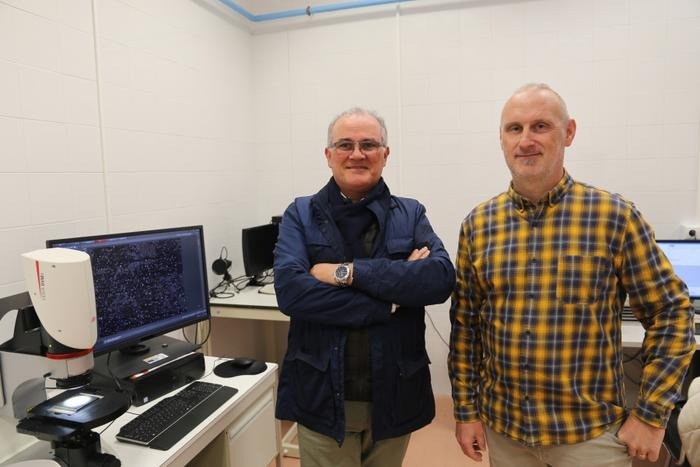Reviewed by Lexie CornerMar 6 2024
A method created by the University of Cordoba yields a straightforward and reliable assessment of the effectiveness and longevity of various commercial non-stick coatings used for food preparation.
 Researchers Guillermo Guerrero and Oscar Rodriguez. Image Credit: University of Cordoba
Researchers Guillermo Guerrero and Oscar Rodriguez. Image Credit: University of Cordoba
Science is incorporated into a plethora of processes by the time a dish is served. From farming methods that produce food that is sustainable and of excellent quality to technological advancements that stop food from sticking to the cookware used to prepare it.
Non-stick coatings have improved the interaction between food and pans for over 60 years because of the development of polytetrafluoroethylene, or Teflon as it is commonly known.
Although the European Union’s medium-term strategy is to reduce or eliminate their use due to potentially harmful effects on health and the environment produced during their manufacture—a point that is still up for debate in the international scientific community—it appears that these fluoropolymer coatings, which stand out for their anti-adhesive power, are nearing the end of their useful life.
As a result, a group at the University of Cordoba’s Department of Mechanics has developed an easy-to-use evaluation protocol by comparing the anti-adhesive power and durability of two conventional fluoropolymer coatings to those of two novel ceramic coatings.
Researchers Guillermo Guerrero, Francisco Comino, and Oscar Rodríguez transformed the lab into a kitchen, making a very sticky pancake dough with rice flour, eggs, and a lot of sugar.
We cooked the pancakes on the different coatings, repeating the action up to 90 times for each option, and we used a special spatula with a dynamometer to measure the peeling force, and we also evaluated how the surface changed with use over time.
Guillermo Guerrero, Study Researcher, University of Cordoba
It was evident that Teflon was still more effective than the new ceramic coatings after measuring the slip angle, the angle at which a drop, usually of water, deposited on a slowly sloping surface begins to slip, as well as the surface’s roughness and wear following dough cooking. When Teflon was used, the peel force needed to lift the dough was reduced by seven to fourteen times. Teflon is, in essence, less sticky.
Guerrero added, “The sol-gel ceramic coatings do not feature optimal anti-adherence, but they have other properties: they are very tough and very resistant to scratching and temperatures, but they demold worse, so we are facing the technological challenge of looking for good solutions to the absence of fluoropolymers.”
In addition to its common usage in food, there are more demanding applications, such as industry, where an efficient alternative is critical.
This non-stick evaluation procedure has been made available by the team, who are also investigating what improvements the new coatings should have. It is inexpensive, simple to use, and appropriate for industrial applications. Meanwhile, the quest for the perfect “non-stick” goes on.
Journal Reference:
Guerrero‐Vaca, G., et al. (2024) Evaluation of the effectiveness and durability of commercial non-stick coatings. Journal of Food Engineering. doi:10.1016/j.jfoodeng.2024.111959